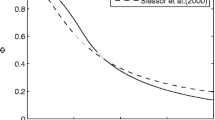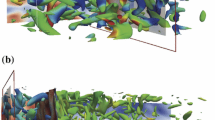Abstract
The need for better understanding of the low-frequency unsteadiness observed in shock wave/turbulent boundary layer interactions has been driving research in this area for several decades. We present here a large-eddy simulation investigation of the interaction between an impinging oblique shock and a Mach 2.3 turbulent boundary layer. Contrary to past large-eddy simulation investigations on shock/turbulent boundary layer interactions, we have used an inflow technique which does not introduce any energetically significant low frequencies into the domain, hence avoiding possible interference with the shock/boundary layer interaction system. The large-eddy simulation has been run for much longer times than previous computational studies making a Fourier analysis of the low frequency possible. The broadband and energetic low-frequency component found in the interaction is in excellent agreement with the experimental findings. Furthermore, a linear stability analysis of the mean flow was performed and a stationary unstable global mode was found. The long-run large-eddy simulation data were analyzed and a phase change in the wall pressure fluctuations was related to the global-mode structure, leading to a possible driving mechanism for the observed low-frequency motions.
Similar content being viewed by others
References
Adams, N.A.: DNS of shock boundary-layer interaction—preliminary results for compression ramp flow. CTR Annual Research Briefs, Center for Turbulence Research, Stanford University and NASA Ames Research Center, Stanford, California (1997)
Adams N.A.: Direct simulation of the turbulent boundary layer along a compression ramp at M = 3 and Re θ = 1685. J. Fluid Mech. 420, 47–83 (2000)
Adamson T.C. Jr, Messiter A.F.: Analysis of two-dimensional interactions between shock waves and boundary layers. Ann. Rev. Fluid Mech. 12, 103–138 (1980)
Andreopoulos J., Muck K.D.: Some new aspects of the shock wave/boundary layer interaction in compression ramp flows. J. Fluid Mech. 180, 405–428 (1987)
Beresh, S.J., Clemens, N.T., Dolling, D.S.: Relationship between upstream turbulent boundary-layer velocity fluctuations and separation shock unsteadiness. AIAA J. 40(12), (2002)
Carpenter, M.H., Nordstrom, J., Gottlieb D.: A stable and conservative interface treatment of arbitrary spatial accuracy. NASA/CR-1998-206921, February 1998
Crouch J.D., Garbaruk A., Magidov D.: Predicting the onset of flow unsteadiness based on global instability. J. Comput. Phys. 224, 924–940 (2007)
Dennis D.J.C., Nickels T.B.: On the limitations of Taylor’s hypothesis in constructing long structures in a turbulent boundary layer. J. Fluid Mech. 614, 197–206 (2008)
Dolling, D.S.: Fifty years of shock-wave/boundary-layer interaction research: what next? AIAA J. 39(8), (2001)
Ducros F., Ferrand V., Nicoud F., Weber C., Darracq D., Gacherieu C., Poinsot T.: Large-eddy simulation of the shock/turbulence interaction. J. Comput. Phys. 152, 517–549 (1999)
Dupont P., Haddad C., Debiève J.F.: Space and time organization in a shock-induced separated boundary layer. J. Fluid Mech. 559, 255–277 (2006)
Dupont, P., Piponniau, S., Sidorenko, A., Debiève, J.F.: Investigation by particle image velocimetry measurements of oblique shock reflection with separation. AIAA J. 46(6), (2008)
Dussauge J.-P., Dupont P., Debiève J.-F.: Unsteadiness in shock wave boundary layer interaction with separation. Aerosp. Sci. Technol. 10, 85–91 (2006)
Dussauge J.-P., Piponniau S.: Shock/boundary-layer interactions: possible sources of unsteadiness. J. Fluids Struct. 24, 1166–1175 (2008)
Eckert, E.R.G.: Engineering relations for friction and heat transfer to surfaces in high velocity flow. J. Aeronaut. Sci. 585–587 (1955)
Erengil, M.E., Dolling, D.S.: Physical causes of separation shock unsteadiness in shock-wave/turbulent boundary-layer interactions. AIAA Paper 93–3134 (1993)
Ganapathisubramani, B., Clemens, N.T., Dolling, D.S.: Effect of upstream coherent structures on low-frequency motion of shock-induced turbulent separation. In: 41st Aerospace Sciences Meenting and Exhibit, AIAA paper 2007-1141 (2007)
Ganapathisubramani B., Clemens N.T., Dolling D.S.: Effects of upstream boundary layer on the unsteadiness of shock-induced separation. J. Fluid Mech. 585, 369–394 (2007)
Garnier, E., Sagaut, P., Deville, M.: Large eddy simulation of shock/boundary-layer interaction. AIAA J. 40(10) (2002)
Gaster M., Kit E., Wygnanski I.: Large-scale structures in a forced turbulent mixing layer. J. Fluid Mech. 150, 23–39 (1985)
Germano M., Piomelli U., Moin P., Cabot W.: A dynamic subgrid-scale eddy viscosity model. Phys. Fluids 3(7), 1760–1765 (1991)
Germano M., Piomelli U., Moin P., Cabot W.: Erratum: a dynamic subgrid-scale eddy viscosity model. Phys. Fluids 3(12), 3128–3128 (1991)
Guarini S.E., Moser R.D., Shariff K., Wray A.: Direct numerical simulation of a supersonic turbulent boundary layer at Mach 2.5. J. Fluid Mech. 414, 1–33 (2000)
Hou, Y.X., Clemens, N.T., Dolling, D.S.: Wide-field PIV study of shock-induced turbulent boundary layer separation. In: 41st Aerospace Sciences Meenting and Exhibit, AIAA paper 2003-0441 (2003)
Huang P.G., Coleman G.N., Bradshaw P.: Compressible turbulent channel flows: DNS results and modelling. J. Fluid Mech. 305, 185–218 (1995)
Hudy, L.M., Naguib, A.M., Humphreys, W.M. Jr.: Wall-pressure measurements beneath a separating/reattaching flow region. Phys. Fluids 15(3), (2003)
Inagaki M., Kondoh T., Nagano Y.: A mixed-time-scale SGS model with fixed model-parameters for practical LES. J. Fluids Eng. 127, 1–13 (2005)
Katzer E.: On the lengthscales of laminar shock/boundary-layer interaction. J. Fluid Mech. 206, 477–496 (1989)
Keating, A., Piomelli, U., Balaras, E., Kaltenbach, H.-J.: A priori and a posteriori tests of inflow conditions for large-eddy simulation. Phys. Fluids 16(12), (2004)
Klein M., Sadiki A., Janicka J.: A digital filter based generation of inflow data for spatially developing direct numerical or large eddy simulations. J. Comput. Phys. 186, 652–665 (2003)
Li, Q.: Numerical study of Mach number effects in compressible wall-bounded turbulence. Ph.D. thesis, School of Engineering Sciences, University of Southampton (2003)
Loginov M.S., Adams N.A., Zheltovodov A.A.: Large-eddy simulation of shock-wave/turbulent-boundary-layer interaction. J. Fluid Mech. 565, 135–169 (2006)
Lund T.S., Wu X., Squires K.D.: Generation of turbulent inflow data for spatially-developing boundary layer simulations. J. Comput. Phys. 140, 233–258 (1998)
Martin M.P.: Direct numerical simulation of a hypersonic turbulent boundary layers. Part 1. Initialization and comparison with experiments. J. Fluid Mech. 570, 347–364 (2007)
Matsumoto M., Nishimura T.: Mersenne Twister: A 623-dimensionally equidistributed uniform pseudorandom number generator. ACM Trans. Model. Comput. Simul. 8(1), 3–30 (1998)
Moin P., Squires K., Cabot W., Lee S.: A dynamic subgrid-scale model for compressible turbulence and scalar transport. Phys. Fluids 3(11), 2746–2757 (1991)
Pirozzoli, S., Grasso, F.: Direct numerical simulation of impinging shock wave/turbulent boundary layer interaction at M = 2.25. Phys. Fluids 18(6), (2006)
Plotkin K.J.: Shock wave oscillation driven by turbulent boundary-layer fluctuations. AIAA J. 13, 1036–1040 (1975)
Ringuette M.J., Wu M., Martin M.P.: Coherent structures in direct numerical simulation of supersonic turbulent boundary layers at Mach 3. J. Fluid Mech. 594, 59–69 (2008)
Robinet J.-Ch.: Bifurcations in shock-wave/laminar-boundary-layer interaction: global instability approach. J. Fluid Mech. 579, 85–112 (2007)
Sagaut, P., Garnier, E., Tromeur, E., Larchevêque, L., Labourasse, E.: Turbulence inflow conditions for large-eddy simulation of compressible wall-bounded flows. AIAA J. 42(3), (2004)
Sandham N.D., Li Q., Yee H.C.: Entropy splitting for high-order numercial simulation of compressible turbulence. J. Comput. Phys. 178, 307–322 (2002)
Sandham N.D., Yao Y.F., Lawal A.A.: Large-eddy simulation of transonic turbulent flow over a bump. Int. J. Heat Fluid Flow 24, 584–595 (2003)
Sandhu, H.S., Sandham, N.D.: Boundary conditions for spatially growing compressible shear layers. Technical Report QMW-EP-1100, Queen Mary University of London (1994)
Spalart, P.R.: Direct simulation of a turbulent boundary layer up to Re θ = 1410. J. Fluid Mech. 187 (1988)
Stewartson K., Williams P.G.: Self-induced separation. Proc. R. Soc. Lond. Ser. A Math. Phys. Sci. 312, 181–206 (1969)
Teramoto, S.: Large-eddy simulation of transitional boundary layer with impinging shock wave. AIAA J. 43(11), (2005)
Thompson K.W.: Time dependent boundary conditions for hyperbolic systems. J. Comput. Phys. 68(1), 1–24 (1987)
Touber, E., Sandham, N.D.: Oblique shock impinging on a turbulent boundary layer: low-frequency mechanisms. In: 38th Fluid Dynamics Conference and Exhibit, AIAA paper 2008-4170 (2008)
Ünalmis, O.H., Dolling, D.S.: Decay of wall pressure field and structure of a mach 5 adiabatic turbulent boundary layer. AIAA paper 94–2363 (1994)
van Driest, E.R.: On turbulent flow near a wall. AIAA J. Special Suppl. Centen. Powered Flight 23(11), (1956)
Veloudis I., Yang Z., McGuirk J.J., Page G.J., Spencer A.: Novel implementation and assessment of a digital filter based approach for the generation of LES inlet conditions. Flow Turbul. Combust. 74(1), 1–24 (2007)
Vreman, A.W.: Direct and large-eddy simulation of the compressible turbulent mixing layer. Ph.D. thesis, Department of Applied Mathematics, University of Twente (1995)
Wu, M., Martin, M.P.: Direct numerical simulation of supersonic turbulent boundary layer over a compression ramp. AIAA J. 45(4), (2007)
Wu M., Martin M.P.: Analysis of shock motion in shockwave and turbulent boundary layer interaction using direct numerical simulation data. J. Fluid Mech. 594, 71–83 (2008)
Xie Z.T., Castro I.P.: Efficient generation of inflow conditions for large-eddy simulation of street-scale flows. Flow Turbul. Combust. 81(3), 449–470 (2008)
Yee H.C., Sandham N.D., Djomehri M.J.: Low-dissipative high-order shock-capturing methods using characteristic-based filters. J. Comput. Phys. 150, 199–238 (1999)
Author information
Authors and Affiliations
Corresponding author
Additional information
Communicated by S. Sarkar
Rights and permissions
About this article
Cite this article
Touber, E., Sandham, N.D. Large-eddy simulation of low-frequency unsteadiness in a turbulent shock-induced separation bubble. Theor. Comput. Fluid Dyn. 23, 79–107 (2009). https://doi.org/10.1007/s00162-009-0103-z
Received:
Accepted:
Published:
Issue Date:
DOI: https://doi.org/10.1007/s00162-009-0103-z
Keywords
- Shock boundary layer interaction
- Global mode
- Compressible turbulence
- LES
- Low-frequency unsteadiness
- Separation bubble
- Digital filter
- Inflow turbulence




